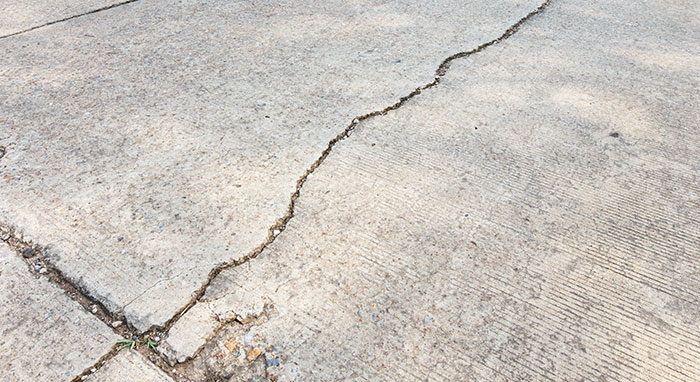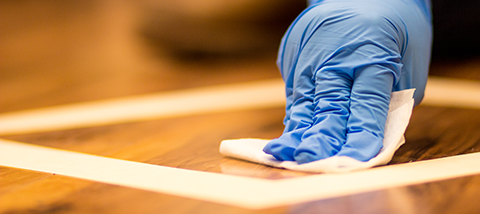
Updated January 23, 2023
Concrete is an incredibly strong material. However, it is not impervious to the elements, and it will develop cracks and other issues over time.
Luckily, it’s relatively inexpensive and easy to repair most concrete driveway cracks.
With that said, not all cracks should be repaired—some concrete should be replaced entirely.
Why do concrete cracks happen?
Before getting into the repair or replace debate, it’s important to understand why concrete cracks in the first place.
Understanding what leads to cracks in concrete can help you make sure the following three mistakes don’t happen...
Mistake #1: Too much water was in the concrete mix.
Concrete doesn’t need a lot of water to reach maximum strength, but in spite of this, a majority of concrete that’s poured has too much water added to the mix at the job site.
This is because the extra water makes the concrete easier and faster to pour and spread.
This excess water contributes to shrinkage which, in turn, leads to cracking.
Shrinkage happens when concrete hardens and dries due to evaporation.
The more water that’s in the concrete mix, the more shrinkage there will be.
This shrinkage creates pressure that pulls the slabs apart.
Mistake #2: The concrete dried too fast.
When concrete dries too quickly, it is weaker and at a higher risk of cracking.
The chemical reaction that occurs when concrete goes from a liquid state to a solid state takes days and weeks to complete.
To ensure the concrete doesn’t dry too fast, it is often “cured” by flooding it or spraying it with water to ensure a slow, even dry time.
Mistake #3: The concrete strength ratio is off.
Concrete can be poured and cured to be a wide range of strengths.
For example, the foundation/floor of a high-rise building will need to be much stronger than a residential driveway.
If the proper strength isn’t achieved, cracks (or bigger problems depending on the situation) are likely to pop up sooner than later.
More information about concrete removal:
- Concrete Demolition & Removal: Everything Homeowners Need to Know
- What You Should Know About Removing a Concrete Patio Attached to a House
Should I repair or remove the concrete?
It can be a bit tricky deciding which approach to take when faced with cracks or other concrete problems.
Removing cracked or damaged concrete is generally your best option, especially if any of the following can be said of the driveway:
- There are multiple cracks. - Wide and deep-set cracks that are uneven or settled on one side are big red flags and can be dangerous if left as is.
- Frost heave has occurred. - In colder climates, frost can cause concrete to push up and become uneven—another cause for concern.
- The concrete is settled. - This happens when the subgrade is not properly leveled and prepared before the concrete is installed.
With that said, some situations only require a simple repair, and replacing it entirely would be a waste of time and money.
Some such situations include:
- There are only thin cracks. - Small, hairline cracks with no evidence of settling rarely call for a replacement.
- The concrete is sunken. - This can be caused by heavy equipment or loads that were placed on the concrete, like a heavy dumpster, for example.
How to fix concrete cracks:
Repairing concrete cracks makes your driveway look better while also protecting it from the elements, like rain, snow, dirt, etc.
Step 1: Prep the area. Use a cleaner that is designed to handle the job at hand.
For example, use a cleaner with a grease-cutting agent if the concrete in the garage has become covered with oil and other automotive fluids.
Step 2: For wider concrete cracks, use a clean chisel and small sledgehammer to undercut the crack’s edges.
This is called “keying,” and it makes the base of the crack wider than at the surface, allowing for a more secure and long lasting repair.
Step 3: Sweep and clean out the crack to remove debris and dust.
A whisk broom and/or a vacuum should do the trick.
Step 4: Patch the crack using a concrete filler.
Make sure you use the patching material according to its directions, and work slowly.
After you’ve filled the crack, check back in a few minutes to see how the filler has settled into the crack.
You may need to add more if it doesn’t look full and snug.
Smooth out the cracks when finished.
Step 5: Allow the patch to cure according to the instructions.
Once the designated time has passed, check back to see if an additional patch is needed.
Step 6: Seal the patch.
Because concrete is so porous and absorbs moisture and stains, sealing it after repairing it is recommended for best results.
How to remove concrete:
Removing concrete isn’t an easy job.
When professionals handle the work, they use an excavator or skid steer loader with a jackhammer attachment or just on old-fashioned, heavy-duty jackhammer.
With heavy-duty equipment like this, removing concrete isn’t too complicated...
- Concrete area is inspected by a professional for utility lines.
- Once area is confirmed clear of utility lines, a dumpster is rented and delivered to the job site.
- Concrete is broken up using specialized equipment.
- Concrete debris is loaded into the dumpster.
- Dumpster is hauled away to the nearest recycling facility/landfill.
Find a concrete removal contractor near you
Learn more about concrete removal:


